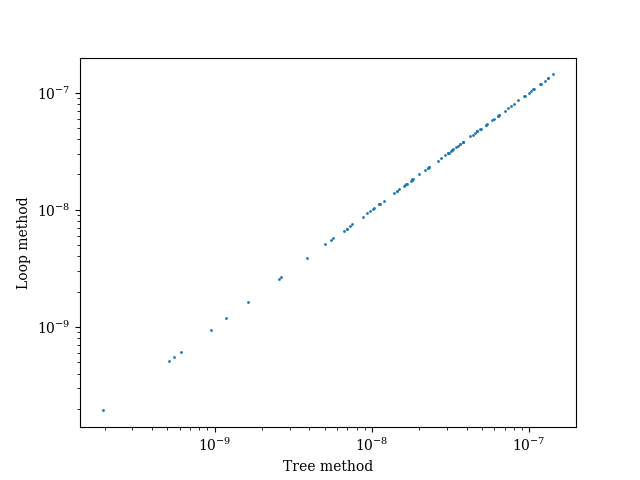Note
Go to the end to download the full example code.
Plot line of sight optical depth calculations¶
This example shows how to compute line of sight optical depths and compares the simple loop method with the complex tree method.

LOS calculation with tree took 0.0004 seconds for nstar=100 and ngas=1000
LOS calculation with loop took 0.0007 seconds for nstar=100 and ngas=1000
Ratio in wallclock: Time_loop/Time_tree=1.8265
Tree gave=3.73e-06 Loop gave=3.73e-06 Normalised residual=0.0000
import time
import matplotlib.pyplot as plt
import numpy as np
from scipy.spatial import cKDTree
from unyt import Mpc, Msun, Myr
from synthesizer.grid import Grid
from synthesizer.kernel_functions import Kernel
from synthesizer.parametric import SFH, ZDist
from synthesizer.parametric import Stars as ParametricStars
from synthesizer.particle.galaxy import Galaxy
from synthesizer.particle.gas import Gas
from synthesizer.particle.particles import CoordinateGenerator
from synthesizer.particle.stars import sample_sfzh
def calculate_smoothing_lengths(positions, num_neighbors=56):
"""Calculate the SPH smoothing lengths for a set of coordinates."""
tree = cKDTree(positions)
distances, _ = tree.query(positions, k=num_neighbors + 1)
# The k-th nearest neighbor distance (k = num_neighbors)
kth_distances = distances[:, num_neighbors]
# Set the smoothing length to the k-th nearest neighbor
# distance divided by 2.0
smoothing_lengths = kth_distances / 2.0
return smoothing_lengths
plt.rcParams["font.family"] = "DeJavu Serif"
plt.rcParams["font.serif"] = ["Times New Roman"]
# Set the seed
np.random.seed(42)
start = time.time()
# Get the location of this script, __file__ is the absolute path of this
# script, however we just want to directory
# script_path = os.path.abspath(os.path.dirname(__file__))
# Define the grid
grid_name = "test_grid"
grid_dir = "../../tests/test_grid/"
grid = Grid(grid_name, grid_dir=grid_dir)
# Define the grid (normally this would be defined by an SPS grid)
log10ages = np.arange(6.0, 10.5, 0.1)
metallicities = 10 ** np.arange(-5.0, -1.5, 0.1)
Z_p = {"metallicity": 0.01}
metal_dist = ZDist.DeltaConstant(**Z_p)
sfh_p = {"duration": 100 * Myr}
sfh = SFH.Constant(**sfh_p) # constant star formation
# Generate the star formation metallicity history
mass = 10**10 * Msun
param_stars = ParametricStars(
log10ages,
metallicities,
sf_hist=sfh,
metal_dist=metal_dist,
initial_mass=mass,
)
xs = {}
loop_ys = {}
tree_ys = {}
precision = {}
n = 100
# First make the stars
# Generate some random coordinates
coords = (
CoordinateGenerator.generate_3D_gaussian(
n,
mean=np.array([50, 50, 50]),
)
* Mpc
)
# Calculate the smoothing lengths
smls = calculate_smoothing_lengths(coords, num_neighbors=56) * Mpc
# Sample the SFZH, producing a Stars object
# we will also pass some keyword arguments for attributes
# we will need for imaging
stars = sample_sfzh(
param_stars.sfzh,
param_stars.log10ages,
param_stars.log10metallicities,
n,
coordinates=coords,
current_masses=np.full(n, 10**8.7 / n) * Msun,
smoothing_lengths=smls,
redshift=1,
)
ngas = 1000
# Now make the gas
# Generate some random coordinates
coords = (
CoordinateGenerator.generate_3D_gaussian(
ngas,
mean=np.array([50, 50, 50]),
)
* Mpc
)
# Calculate the smoothing lengths
smls = calculate_smoothing_lengths(coords, num_neighbors=56) * Mpc
gas = Gas(
masses=np.random.uniform(10**6, 10**6.5, ngas) * Msun,
metallicities=np.random.uniform(0.01, 0.05, ngas),
coordinates=coords,
smoothing_lengths=smls,
dust_to_metal_ratio=0.2,
)
# Create galaxy object
galaxy = Galaxy("Galaxy", stars=stars, gas=gas, redshift=1)
# Get the kernel
kernel = Kernel().get_kernel()
# Calculate the tau_vs
start = time.time()
loop_tau_v = galaxy.calculate_los_tau_v(
kappa=0.07,
kernel=kernel,
force_loop=1,
)
loop_time = time.time() - start
loop_sum = np.sum(loop_tau_v)
# Calculate the tau_vs
start = time.time()
tree_tau_v = galaxy.calculate_los_tau_v(
kappa=0.07,
kernel=kernel,
min_count=100,
)
tree_time = time.time() - start
tree_sum = np.sum(tree_tau_v)
print(
f"LOS calculation with tree took {tree_time:.4f} "
f"seconds for nstar={n} and ngas={ngas}"
)
print(
f"LOS calculation with loop took {loop_time:.4f} "
f"seconds for nstar={n} and ngas={ngas}"
)
print(
"Ratio in wallclock: " f"Time_loop/Time_tree={loop_time / tree_time:.4f}"
)
print(
f"Tree gave={tree_sum:.2e} Loop gave={loop_sum:.2e} "
"Normalised residual="
f"{np.abs(tree_sum - loop_sum) / loop_sum * 100:.4f}"
)
print()
# Plot the optical depths against each other.
fig, ax = plt.subplots()
ax.scatter(tree_tau_v, loop_tau_v, s=1)
ax.set_xscale("log")
ax.set_yscale("log")
ax.set_xlabel("Tree method")
ax.set_ylabel("Loop method")
plt.show()
Total running time of the script: (0 minutes 1.028 seconds)